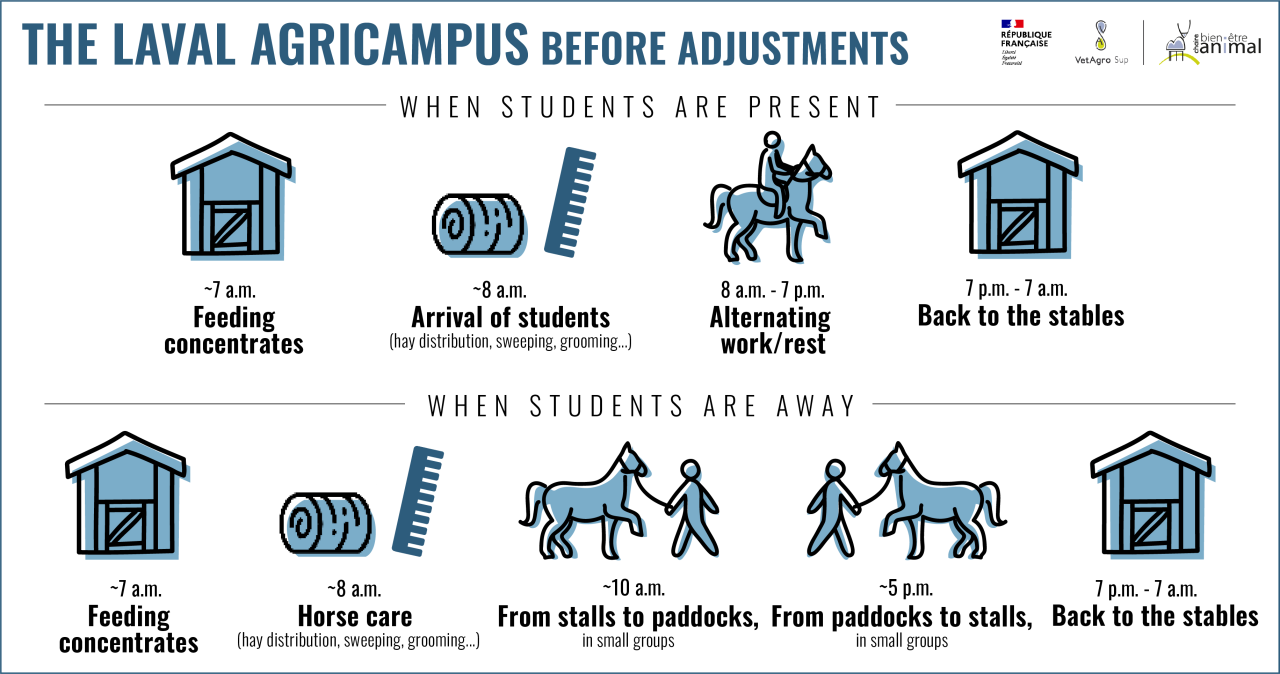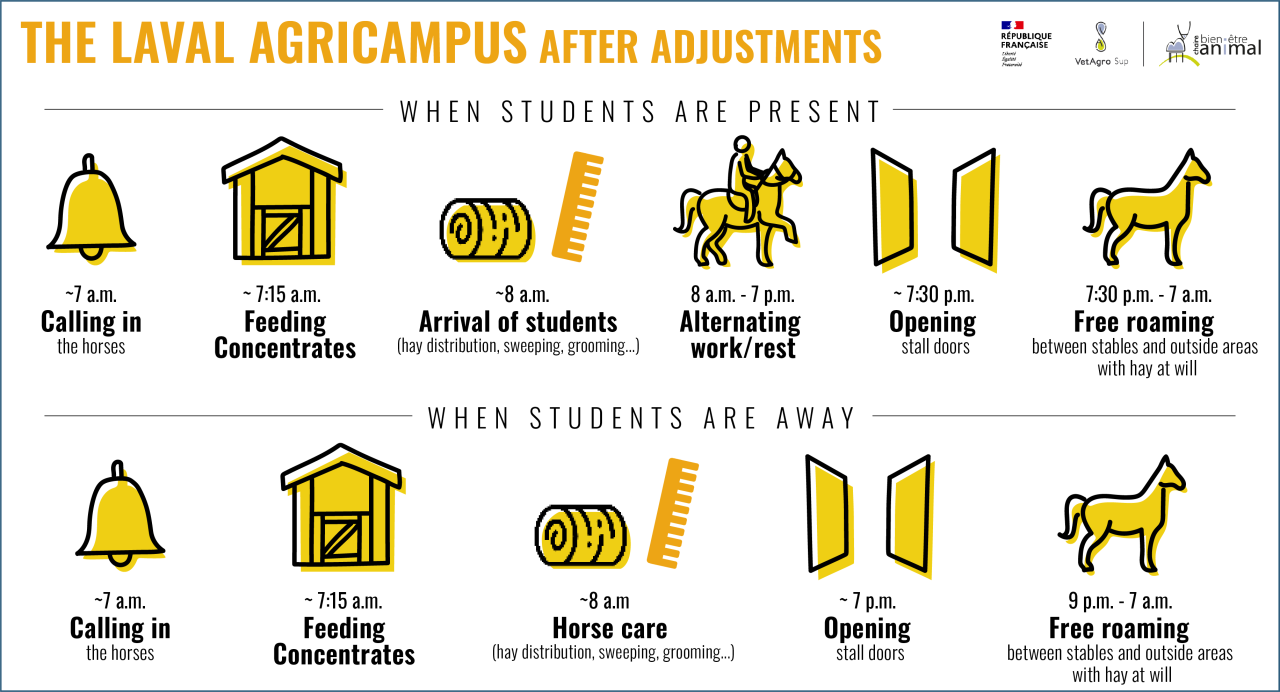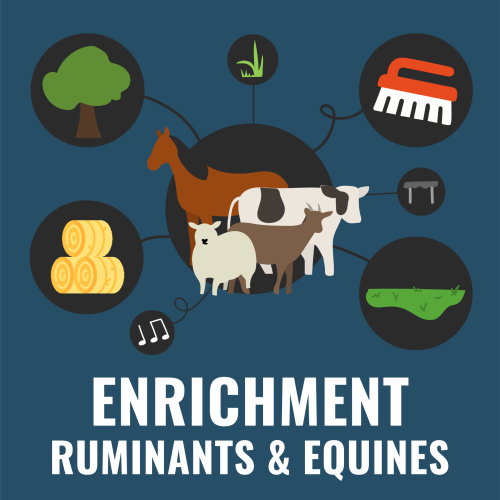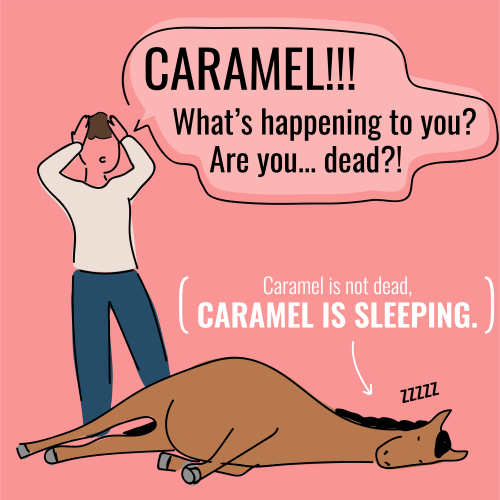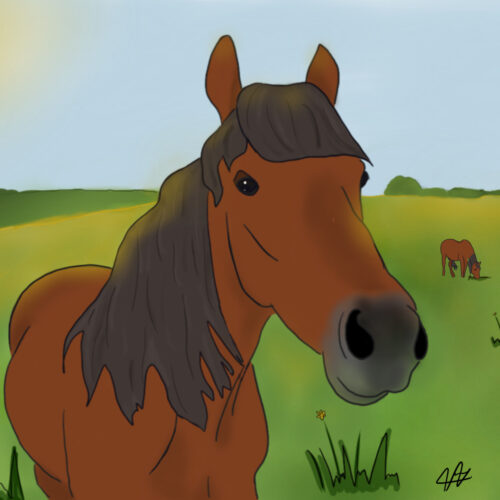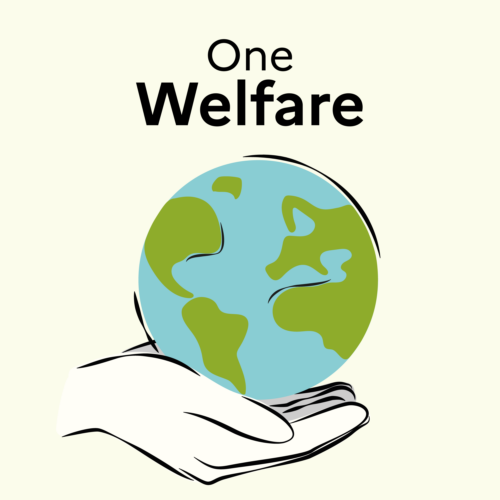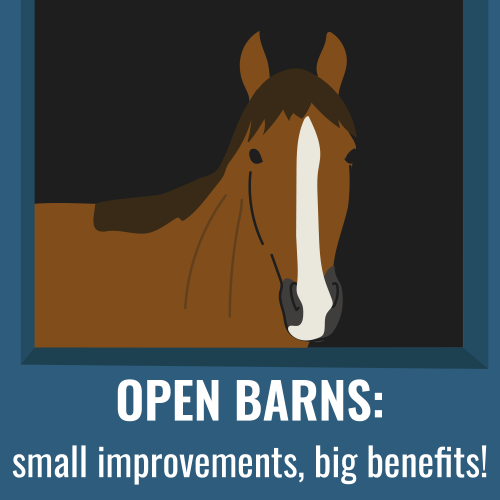
On February 14 and 15, 2024, BATICE and ONE WELFARE – both RMTs (Réseaux Mixtes Technologiques) – held two days of conferences in Rennes on the topic: “Livestock buildings, where man and animal meet“.
On this occasion, Alice Ruet, ethologist and research and development engineer at the Institut français du cheval et de l’équitation (IFCE) and INRAe, accompanied by Ambre Sélébard, apprentice at IFCE, presented the results and lessons learned from a case study carried out at the Laval AgriCampus high school.

Keep in mind
- Consistent opportunities for turnout, high-fiber forage, and companionship are crucial for the welfare of stall-bound horses
- Open barns such as the ones organized at the Laval AgriCampus can meet these needs for many horses, without major investment
- This organizational innovation benefits both the horses and their human caretakers: it is a win-win situation
On February 14 and 15, 2024, BATICE and ONE WELFARE – both RMTs (Réseaux Mixtes Technologiques) – held two days of conferences in Rennes on the topic: “Livestock buildings, where man and animal meet“.
On this occasion, Alice Ruet, ethologist and research and development engineer at the Institut français du cheval et de l’équitation (IFCE) and INRAe, accompanied by Ambre Sélébard, apprentice at IFCE, presented the results and lessons learned from a case study carried out at the Laval AgriCampus high school.
Laval AgriCampus: a traditional organization
This agricultural teaching establishment has an Equestrian Technology Workshop, with 28 training horses in the stable. Until now, they were housed in individual stalls with weekly access to the paddock
The horses only had access to the outdoors outside the students’ training periods (weekends and vacations), which meant that they had to be led in small groups from stall to paddock and vice versa.
The rest of the time, the horses were either ridden or kept in stalls, where they did not enjoy turnout, social interaction with other horses or unlimited feed – the 3 basic needs of horses, essential to their welfare.
In addition to being time-consuming and a source of risk for employees, such an organization was problematic in terms of welfare.
The negative consequences of permanent stall housing
The individual stall is still the most common form of housing for horses in France. It entails varying degrees of restrictions, depending on turnout and feeding management practices[1].
Yet housing horses mainly in individual stalls is a major risk factor for horse welfare. The results of a meta-analysis[2] published in 2021 show that the combination of social, spatial and dietary restrictions leads to a significant development of passive responses (i.e., decreased responsiveness to external stimuli, decreased expression of natural behaviors such as lying down, expression of depressive behaviors) and abnormal behaviors (i.e., stereotypies or tics, self-mutilation, aggression towards humans, chewing of wood, bedding and dung)[3].
This deterioration in welfare has a direct impact on the horse’s emotional state: horses housed solely in stalls are much more pessimistic[4].
This negative emotional state even affects riding, since unhappiness in the stall has been associated with changes in the horses’ behavior and locomotion when ridden[5].

To preserve the welfare of horses and promote more ethical horsemanship, we must consider profound and lasting changes to the current living conditions of horses in individual stalls.
ALICE RUET
To achieve this, it seems necessary to encourage the satisfaction of their basic needs whenever possible, through free outings, social interaction and fiber consumption.
For example, access to a free-range outdoor area (with water and hay/grass), even for a short time (a maximum of 1 hour for 5 days a week in the study in question), significantly improves the horses’ welfare, resulting in less stereotypies when stalled. But this positive effect is short-lived: for it to last, regular free-range outings are needed[6].
📌 Holidays in the meadow[7] !
A common practice is to offer pasture “holidays” to horses housed in individual stalls for the rest of the year. This has a number of positive impacts on the horses’ state of welfare (reduced stereotypies, reduced hypervigilance and aggression towards humans, increased social interaction).
However, it is important to note that:
- A period of about twenty days is necessary for some horses to adjust to this sudden change of environment. Horses with prior observable environmental unresponsiveness in the stall (before being put out to pasture in a group) may see this exacerbated, which is characteristic of the adaptation period.
- Return to individual stalls is perceived very negatively.
- The benefits of life in the meadow do not last; a return to the initial state (before holidays) is observed within about 3 months.
Putting your horse out to pasture cannot be improvised: learn about the main principles here: “A horse in the pasture is a happy horse: true or false?”
Simple, inexpensive adjustments...
The Equestrian Technology Workshop at Laval AgriCampus therefore decided to modify its organization with the dual aim of improving safety and comfort at work, and the living conditions of the equines, both of which are closely linked. This concept is called One Welfare.
To avoid heavy investment, the choice was made to simply open the stall doors at the end of the day. The horses can now choose to stay in the stable or go out and roam freely outdoor. This space includes the stable yard, enclosed by removable wires, a stabilized area equipped with several racks and, weather permitting, a 1.2-hectare paddock.
Horses roam freely until 7 a.m. when, on a call from their caretaker, they return to the stable to be fed.
Overview of the Equestrian Technology Workshop, Laval site:
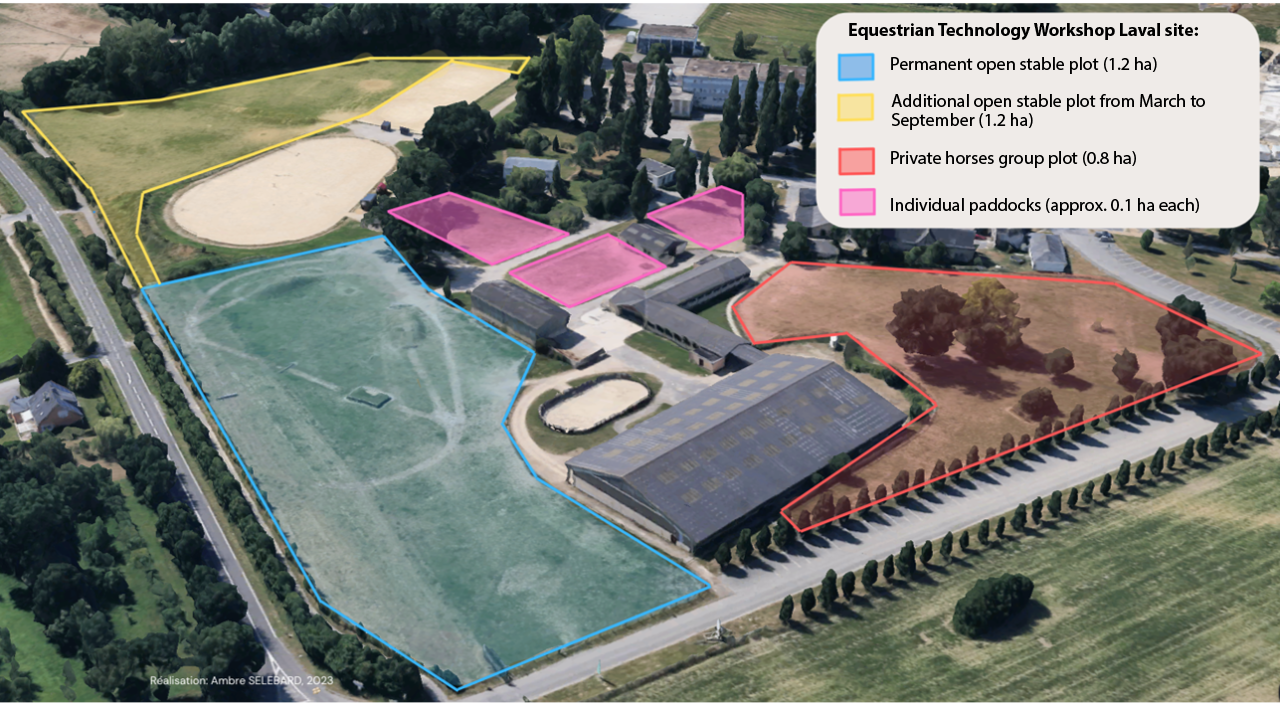
... for real benefits!
The benefits:
- Improved human-animal relationship
- Unlimited hay for at least 12 hours a day, in addition to the hay and straw available in the stall.
- Free roaming for at least 12h/d
- Available surface area from 50 to 900m² per horse, depending on the weather and season
- Reduced hard work and risks for employees, who no longer have to lead the horses in and out
- Low financial investment (ground stabilization, racks, fencing wires and handles): €34,777.
- Concentrated feed consumption divided by 3
- Straw consumption (bedding) divided by 2
Disadvantages:
- Presence of alopecia (hairless areas) and minor injuries linked to group life,
- Dung, hay and straw scattered throughout the open stable area, requiring appropriate cleaning.
- Longer grooming time
- Daily tidying of indoor and outdoor areas accessible to the horses
- A stable group over time is required to limit aggressive interactions between individuals
- Wide corridors are needed to prevent the horses from getting stuck
- Non-slip interior and exterior surfaces are needed
- Morphological changes in some horses are observed, with some showing rounder bellies, and others slightly less healthy (based on students’ and teachers’ perception, no objective data on this aspect).
Find out more about this project
Stalls open at the end of the day:
Free roaming around the stable courtyard:
Thanks for proofreading: Alice Ruet and Françoise Lumale (IFCE).
[1] https://www.ifce.fr/wp-content/uploads/2020/10/Le-bien-%C3%AAtre-du-cheval-de-l%E2%80%99h%C3%A9bergement-%C3%A0-l%E2%80%99%C3%A9quitation.pdf
[2]Cross-tabulation of results obtained in 38 independent studies addressing the same research question.
[3] Krueger, K., Esch, L., Farmer, K., Marr, I., 2021. Basic needs in horses?—a literature review. Animals 11, 1–16. https://doi.org/10.3390/ani11061798
Ruet, Alice & Lemarchand, Julie & Parias, Céline & Mach, Nuria & Moisan, Marie-Pierre & Foury, Aline & Briant, Christine & Lansade, Lea. (2019). Housing Horses in Individual Boxes Is a Challenge with Regard to Welfare. Animals. 9. 621. . . . https://doi.org/10.3390/ani9090621
[4]Sandra Löckener, Sven Reese, Michael Erhard, Anna-Caroline Wöhr. Pasturing in herds following housing in horseboxes induces a positive cognitive bias in horses. Journal of Veterinary Behavior, January–February, 2016, Volume 11, Pages 50–55
[5] Ruet, Alice & Biau, Sophie & Arnould, Cécile & Galloux, Patrick & Destrez, Alexandra & Pycik, Elena & Boichot, Laetitia & Lansade, Lea. (2020). Horses could perceive riding differently according to the way they express poor welfare in the stable. Journal of Equine Veterinary Science. 94. https://doi.org/10.1016/j.jevs.2020.103206 .
[6] La mise au paddock des chevaux de sport : faisabilité et impact sur le bien-être. Journées sciences et innovations équines 2019, Ifce. Martine Hausberger, Lola Reverchon-Billot, Clémence Lesimple, Caroline Coste, Laetitia Boichot, Patrick Galloux, Séverine Henry.
[7] RUET A., ARNOULD C., LEVRAY J., LEMARCHAND J., MACH N., MOISAN M.P., FOURY A., BRIANT C. et LANSADE L. (2020). Effects of a temporary period on pasture on the welfare state of horses housed in individual boxes. Appl. Anim. Behav. Sci., 228, 105027.
Keep in mind
- Consistent opportunities for turnout, high-fiber forage, and companionship are crucial for the welfare of stall-bound horses
- Open barns such as the ones organized at the Laval AgriCampus can meet these needs for many horses, without major investment
- This organizational innovation benefits both the horses and their human caretakers: it is a win-win situation

To preserve the welfare of horses and promote more ethical horsemanship, we must consider profound and lasting changes to the current living conditions of horses in individual stalls.

ALICE RUET

